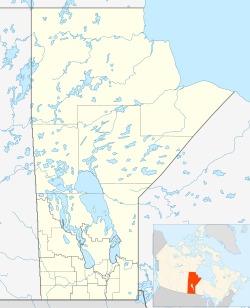world.wikisort.org - Canada
Springfield is a rural municipality (RM) in Manitoba, Canada. It stretches from urban industrial development on the eastern boundary of the City of Winnipeg, through urban, rural residential, agricultural and natural landscapes, to the Agassiz Provincial Forest on the municipality's eastern boundary. Birds Hill Provincial Park nestles into the north-western corner of Springfield.
Springfield | |
|---|---|
Rural municipality | |
| Rural Municipality of Springfield | |
 Birds Hill Provincial Park in northwestern Springfield | |
 Springfield | |
| Coordinates: 49°55′45″N 96°41′38″W | |
| Country | Canada |
| Province | Manitoba |
| Region | Winnipeg Metro Region |
| Incorporated | 1880 |
| Government | |
| • Mayor | Patrick Therrien |
| • MLAs |
|
| • MPs |
|
| Area | |
| • Rural municipality | 1,096.17 km2 (423.23 sq mi) |
| • Metro | 530,679 km2 (204,896 sq mi) |
| Elevation | 242 m (794 ft) |
| Population (2021)[1] | |
| • Rural municipality | 16,142 |
| • Density | 15/km2 (38/sq mi) |
| • Metro | 778,489 |
| Time zone | UTC−6 (CST) |
| • Summer (DST) | UTC−5 (CDT) |
| Postal Code | R5L, R5M, R5N, R5P, R5R, R5T |
| Area codes | 204, 431 |
| Website | www |
Springfield's population was 16,142 as of the 2021 census, making it the second most populous RM in the province (slightly behind the RM of Hanover) and fifth most populous municipality overall (behind the cities of Winnipeg, Brandon, and Steinbach, and RM of Hanover).[1]
History
Springfield was incorporated in 1880 as a result of changes made to the Rural Municipality of Springfield and Sunnyside (1873–1880).[2] The municipality received its name due to the presence of multiple natural springs found within its borders.[3] While farming is still important in the municipality, today many residents are employed in nearby Winnipeg.
Communities
- Anola
- Cooks Creek
- Dugald
- Glass
- Hazelridge
- Oakbank
- Ostenfeld
- Pine Ridge
- Sapton
- Vivian
Demographics
In the 2021 Census of Population conducted by Statistics Canada, Springfield had a population of 16,142 living in 5,795 of its 5,992 total private dwellings, a change of 5.2% from its 2016 population of 15,342. With a land area of 1,096.17 km2 (423.23 sq mi), it had a population density of 14.7/km2 (38.1/sq mi) in 2021.[1]
|
| ||||||||||||||||||||||||||||||||||||||||||||||||||||||||||||||||||||||||
Attractions
The RM of Springfield contains many sites of historical and cultural significance such as the Sunnyside cemetery, the Springfield Hutterite colony, North Springfield school, Springfield Agricultural Society, and the Dugald rail accident site.[5]
In 1996, the Ukrainian Catholic Church of the Immaculate Conception in Cooks Creek was designated a National Historic Site of Canada.[6]
Government
Municipal
Springfield's administrative center is in Oakbank, the largest community in the RM. The RM is governed by a mayor and councillors representing the RM's five wards. The government has come under some scrutiny[according to whom?] for having the highest compensation to mayor and council ($242,974 total for 2015) relative to all other municipalities in the Winnipeg capital region.[7]
Provincial
The RM is represented by two ridings in the Manitoba Legislative Assembly: Springfield-Ritchot (west) and Dawson Trail (east). The former Springfield electoral district included all of the RM and parts of adjacent East St. Paul.
Federal
The RM is split between two federal ridings: Selkirk—Interlake—Eastman (north) and Provencher (south). From 1914 through 1966, a federal riding was also called "Springfield" with varying boundaries not always coterminous with the municipality.[8]
References
- "Population and dwelling counts: Canada, provinces and territories, and census subdivisions (municipalities), Manitoba". Statistics Canada. February 9, 2022. Retrieved February 20, 2022.
- Goldsborough, Gordon (March 1, 2022). "Manitoba Communities: Springfield (Rural Municipality)". Manitoba Historical Society. Manitoba Historical Society. Retrieved March 27, 2022.
- Manitoba Department of Industry and Commerce (2000). Geographical Names of Manitoba. Winnipeg: Manitoba Conservation. ISBN 0-7711-1517-2. OCLC 51764498.
- Goldsborough, Gordon (February 11, 2022). "Manitoba Communities: Springfield (Rural Municipality)". Manitoba Historical Society. Retrieved March 27, 2022.
- "Search results for "Springfield"". Manitoba Historical Society. Manitoba Historical Society. Retrieved 17 October 2015.
- "Ukrainian Catholic Church of the Immaculate Conception National Historic Site of Canada". Parks Canada - Directory of Federal Heritage Designations. Parks Canada. Retrieved March 28, 2022.
- Bill Redekop (17 February 2015). "Salaries for municipal leaders in the capital region vary widely – Winnipeg Free Press". Winnipegfreepress.com. Retrieved October 29, 2015.
- "SPRINGFIELD, Manitoba (1914 - 1966)". Parliament of Canada. Library of Parliament. Archived from the original on October 23, 2012.
Further reading
- Kraushar, Aileen, et al. 1974. Springfield 1st Rural Municipality in Manitoba 1873-1973. Dugald: Dugald Women's Institute. ISBN 0-919212-40-9.
External links
- R.M. of Springfield (official site)
- Community Profile: Springfield Rural Municipality, Manitoba; Statistics Canada
- Map of Springfield R.M. at Statcan
Другой контент может иметь иную лицензию. Перед использованием материалов сайта WikiSort.org внимательно изучите правила лицензирования конкретных элементов наполнения сайта.
WikiSort.org - проект по пересортировке и дополнению контента Википедии
